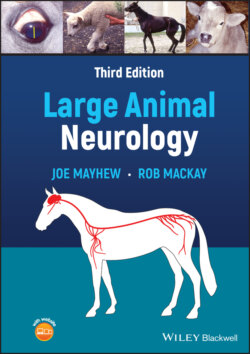Читать книгу Large Animal Neurology - Joe Mayhew - Страница 77
Blocking tissues
ОглавлениеIf it is worth harvesting tissues at postmortem examination, then it is worth routinely blocking tissues in all cases. This will obviously be modified where there is a specifically known site (e.g., right cerebrum, left vestibular nuclei, right T6, etc.) and when collection of, and particularly blocking of, tissues will focus on those sites in the first instance.
For a routine case with signs relating to a brain lesion, the entire brain should be harvested along with at least one trigeminal ganglion lying slightly lateral and projecting rostral to the optic chiasm. If vestibular signs are indicated, the skull should be sectioned transversely after brain removal at the level of the external acoustic meati for an inspection of the ear cavities. If no specific lesion site is indicated clinically or grossly, routine brain harvesting and fixation should proceed. The brain can then be cut into transverse 5–10 mm slices except for the cerebellum that should be sectioned initially on a median plane after sectioning its peduncles. The brain histopathology blocks would routinely be taken from the sites indicated in Figure 4.4, taking samples from the right side of the preserved brain as a routine unless otherwise indicated. These sites are selected based on sites of lesions for commonly occurring and for important diseases (e.g., rabies, cerebellar abiotrophy, and neuroaxonal dystrophy), and should be varied and added to depending on clinical signs, gross pathologic findings, funding available, and the regional experience of the neuropathologist.
Figure 4.4 Suggested levels for taking routine brain sections for histopathologic study. Selected brain regions to be routinely viewed (A). Sites for routine sectioning (B). Examples of final routine brain histologic sections (C).
With spinal cord cases where clinical documentation or gross findings indicate a specific site, then sections from this area should take priority. With no clinically or grossly documented focal lesion identified, then in addition to spinal cord, peripheral nerves (e.g., median and sciatic) and the brain should be harvested. Routine blocking of spinal cord should include two cervical, two thoracic, and one lumbar set of sections, each sampled on a transverse plane, a dorsal longitudinal plane, and a median longitudinal plane orientation (Figure 4.5). Again, a documented focal or multifocal lesion will dictate sampling sites. The remainder of the cord should be replaced in fixative such that the orientation of parts is still evident for future sub‐sectioning.
As with the brain tissues, unless focal or multifocal sites of lesions are grossly very clear, a methodical approach of sectioning selected spinal cord segments should be taken. This enables the identification of sections being above and sections being below focal lesions so that such focal lesions can be pinpointed to assess possible cause. One system of such histopathologic sleuthing is depicted in Figure 4.5.
In a neurologic case involving final neuronal pathways, especially when the lesion site(s) is unknown, proximal and distal major nerves along with nerve roots and selected dorsal root, paravertebral and autonomic ganglia, and selected muscle samples should also be harvested. Longitudinal as well as transverse sections of peripheral nerves and muscles should be clearly identified as to orientation for processing.
